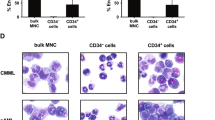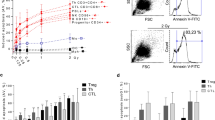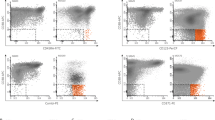Abstract
In this study, we evaluated the effect of hyperthermia on hematopoietic progenitors from six chronic myeloid leukemia (CML) bone marrow (BM) samples at diagnosis and four peripheral blood stem cell (PBSC) samples from CML patients after stem cell mobilisation. CD34-positive cells, isolated from these samples, were incubated for 2 h at 37, 42 or 43°C and were plated in the colony-forming unit granulocyte–macrophage (CFU-GM) and the long-term culture initiating cell (LTCIC) assay. To evaluate purging, individual colonies from these assays were analyzed for the presence of the bcr-abl gene with interphase fluorescence in situ hybridization (FISH) and/or RT-PCR. BM samples showed a significant higher sensitivity both at the CFU-GM and LTCIC level, after treatment at 42°C, as compared to the control BM samples obtained from healthy volunteers. The four BM samples of CML patients with a low leukocyte number at diagnosis harbored a mixture of bcr-abl-negative and positive colonies and an increase in the percentage of bcr-abl-negative colonies was observed in all cases. CML patients with a high leukocyte count at diagnosis, however, showed only bcr-abl-positive progenitors even after hyperthermia. PBSCs showed a significant higher sensitivity at the LTCIC level but not at the CFU-GM level, after treatment at 42°C, as compared to the control PBSC samples obtained from non-hematologic cancer patients. Molecular analysis of individual colonies demonstrated an increase of bcr-abl-negative progenitors after thermic treatment in two out of three samples. When comparing both stem cell sources, PBSCs showed a decreased thermic sensitivity as compared to the BM samples at the CFU-GM level, whereas at the LTCIC level an increased thermic sensitivity was observed, both for the controls and the CML samples. In conclusion, both for BM and PBSCs samples, CML progenitors are more sensitive to hyperthermia than control cells, especially at the LTCIC level. In agreement with these results, an increase of bcr-abl-negative progenitors in six out of seven samples could be demonstrated either at the CFU-GM level, LTCIC level or both. Hyperthermia should be explored further as a possible purging modality in CML.
This is a preview of subscription content, access via your institution
Access options
Subscribe to this journal
Receive 12 print issues and online access
$259.00 per year
only $21.58 per issue
Buy this article
- Purchase on Springer Link
- Instant access to full article PDF
Prices may be subject to local taxes which are calculated during checkout
Similar content being viewed by others
Author information
Authors and Affiliations
Rights and permissions
About this article
Cite this article
Thijsen, S., van Oostveen, J., Schuurhuis, G. et al. Hypersensitivity of bcr-abl-positive progenitors to hyperthermia in patients with chronic myeloid leukemia. Leukemia 11, 1762–1768 (1997). https://doi.org/10.1038/sj.leu.2400799
Received:
Accepted:
Issue Date:
DOI: https://doi.org/10.1038/sj.leu.2400799



